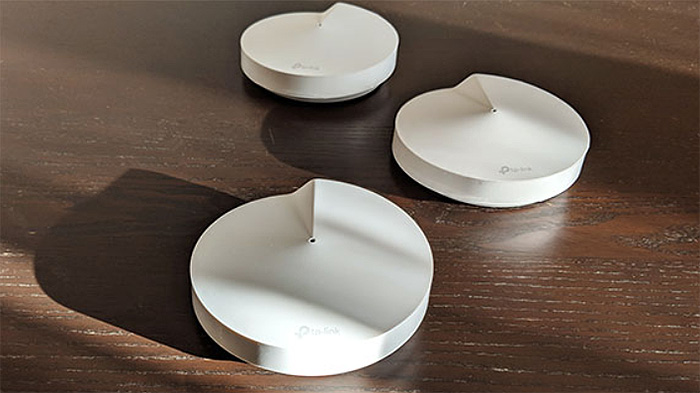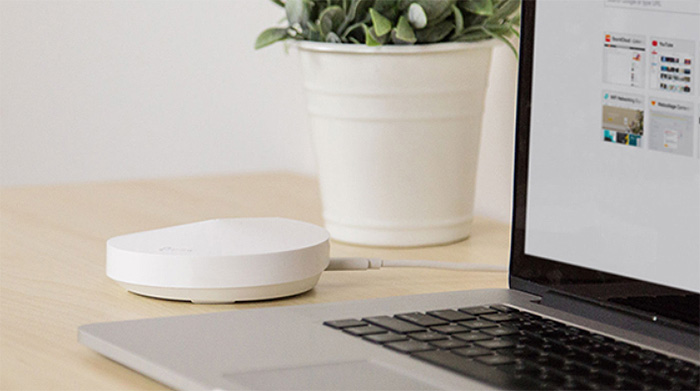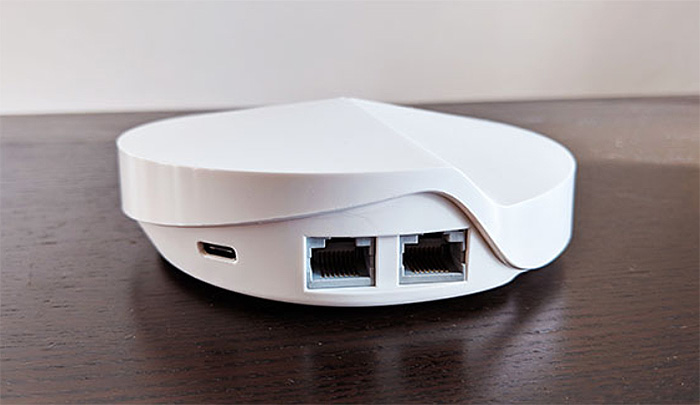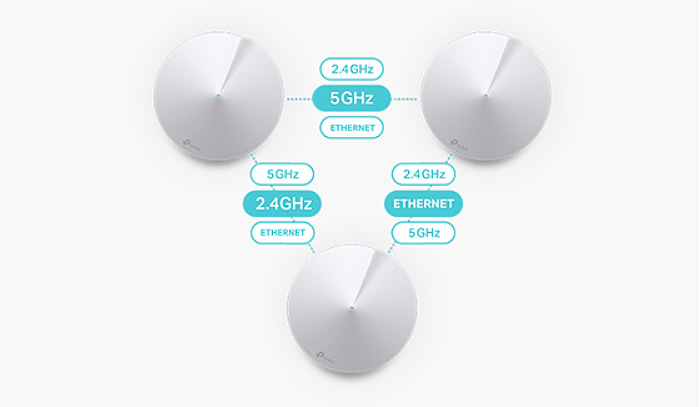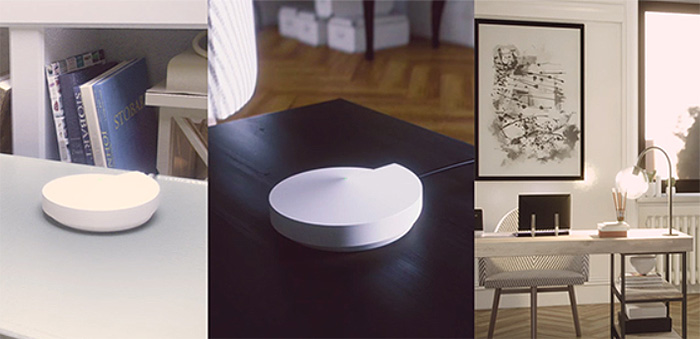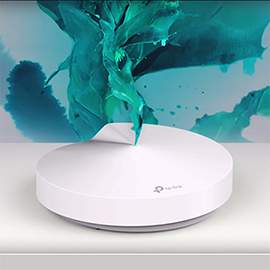The TP-Link Deco M5 was the first WiFi system released by the Shenzhen-based company in an attempt to join the then-already established group of systems, which included the the Linksys Velop, the Google WiFi and the Netgear Orbi. The WiFi systems were and still are the hottest thing in the networking world (right next to the new 802.11ax) and every major manufacturer wanted to have its product on display. Some of the early solutions came from Eero, Ubiquiti, Luma and Open Mesh, but, as expected, the more popular networking manufacturers have jumped on the bandwagon and released their own versions of how a WiFi system should look and behave, which meant a radical increase in options, lots of interesting features and new implemented technologies, as well as a significant decrease of prices (with a fiercer competition, come better prices).
| TP-Link Deco M5 | |
|---|---|
| Amazon.com | Check Offer |
Considering that it was a bit late to the party, the Deco M5 already had a fierce competition from the likes of Google WiFi (also a dual-band WiFi system), so it had to bring some novelty to the table and improve the WiFi system formula to actually become relevant and not just have a better price tag.
The Google WiFi kept the dual-band setup, but brought the price down and implemented a very simple and minimalist setup and interface (while also being one of the best on a key necessity: the network stability); the Linksys Velop added a second 5GHz radio band so it could better handle clients and the backhaul traffic; the Netgear Orbi also has an additional 5GHz which is dedicated to the backhaul, while it rejected the mesh approach in favour for a main unit+satellites system (eventually it came around and now supports daisy-chain).
Similarly to Google WiFi and Eero, TP-Link Deco M5 is a dual-band MU-MIMO router and one differentiating factor is the HomeCare, which works as an integrated antivirus and antimalware feature (this is only available with the three-unit pack). It’s not the first time a mesh system is advertised as having built-in Security features (Luma), so let’s see if TP-Link got things better.
UPDATE 03.30.2019: About 2 years have passed since I first tested the TP-Link Deco M5, so I decided to revisit it and see if TP-Link made substantial improvements to its original WiFi system. As a side note, the Deco M5 that I will retest is v1.0 and I know that TP-Link has also released a second version of the system, but the only difference between them seems to be the Power port (a downgrade from the universal type-C to a regular round Power port).

ALSO CHECK OUT: TP-LINK DECO M5 VS GOOGLE WIFI
Design
While the latest high-end routers get bigger and flashier with every iteration, the WiFi systems have always been discreet and unobtrusive (even from the early days of Eero and OpenMesh) and the TP-Link Deco M5 has kept this tradition (along with its younger siblings, the tri-band M9 Plus and the Deco P7 which has implemented powerline support). The Deco M5 can be purchased as a single unit or as multiple units (while the standard is the three-unit pack) and every M5 router is identical with each other (this is the case with every wireless mesh systems).
A single TP-Link Deco M5 features a relatively compact plastic case, which is covered by a matte finish (it does not retain any fingerprints) and the first time you take a look at its exterior you will notice the unusual shape it has adopted: there’s a seashell fractal design on top, with the plastic spiraling downwards and, in the middle, there’s a small LED light. Similarly to the Google WiFi, there aren’t many parts to reveal that this is a networking device and, if it wasn’t for the wire which sticks from the back of the M5, you would think that it’s just a strange piece of modern art. Sure, the Deco M5 may not be as aesthetic pleasing as Google WiFi, but I do appreciate that it’s less intrusive than both Linksys Velop and Netgear Orbi, measuring 4.7 x 1.3 inches and weighing 8 ounces (slightly larger than Google WiFi, but less tall).
The lightness of the device could raise some concerns about the stability, but since it’s not tall enough to be accidentally hit off the table, its four rubber feet and its low profile should be enough not to worry about it budging or falling. If you look all around the case, you won’t notice any cut-outs or vent holes, but, if you turn the device around, the bottom side is filled with puncture holes which have the role of keeping the device cool.
While testing the device, the Deco M5 got decently warm and, even if it didn’t overheat, it has a higher temperature than the Google WiFi which completely lacks any ventilation holes. Similarly to any other WiFi systems on the market, you can’t mount the device on the wall or ceiling and the only available position is horizontally on a flat surface. But, because of its reasonably small proportions, you get the option to place the M5 units pretty much anywhere in the room (the same as the Google WiFi points) and it will fit right in with any type of furniture.
Just like the Linksys Velop, the Deco M5 has a small top LED light and while other manufacturers went for something more flashy, TP-Link preferred a small, almost unnoticeable and weirdly placed LED light to show the status of the device and network: if the LED is solid yellow, then the device is starting up, while, if the LED is flashing a blue colour, then the Deco unit is ready for setting up (a solid blue signifies that the unit is setting up); if the LED light is solid green, then the Deco M5 router is connected to the Internet and everything is in order; lastly, if the LED is solid red, then the unit has encountered an error and you should check the app for details.
The LED lights can be turned off during the night (switch on the Night Mode from the Advanced Menu). I have noticed that basically all WiFi systems use a single LED system instead of the common, easy-to-understand array of indicators and it seems that TP-Link also thinks this is a good idea. While it may seem minimalist and engaging on paper to have a colourful LED, in reality, I found the system to be unintuitive and hard to understand, since you need the manual nearby to actually follow what do colours mean. Some WiFi systems are compatible with Amazon Alexa and the voice-based commands system can definitely evolve into something better than the generic array of LEDs, but, so far, this is not supported by TP-Link Deco M5 – the Deco M5 does support Alexa.
On the rear side of every TP-Link Deco M5 there is a USB Type-C port (so far, it can only be used for powering up the device and you can’t add any external storage device or any ZigBee dongle – as a side note, some other WiFi systems have inactive USB ports) and two Gigabit 10/100/1000 Mbps Ethernet ports (WAN/LAN), while on the bottom side, you can find a Reset button (used to return the device to factory default settings) and a label with printed info about the device.
Note: Inside the package (the three-unit box), you can find three TP-Link Deco M5 units, three Power adapters and one RJ45 Ethernet cable. No, I haven’t forgotten to add the user guide/manual, instead it was a conscious choice from TP-Link to show how intuitive their system is that you don’t need one. Funny enough, it’s already needed to understand the LED colours.
Hardware
TP-LINK Deco M5 is built on the same platform as Linksys Velop, Google WiFi and Netgear Orbi, although it does not take advantage of all the wave 2 features. So, we’re dealing with a quad-core Qualcomm Atheros IPQ4019 chip (clocked at 638 MHz), 256 MB of RAM (Nanya NT5CC128M16IP-DI), 32MB NOR flash memory and a Qualcomm Atheros QCA8072 switch chipset. Furthermore, the 2.4GHz radio band uses the Qualcomm Atheros IPQ4019 chip, while the 5GHz radio band also makes use of the Qualcomm Atheros IPQ4019 chipset, along with Qorvo RFMD RFPA5542 Power Amplifier.
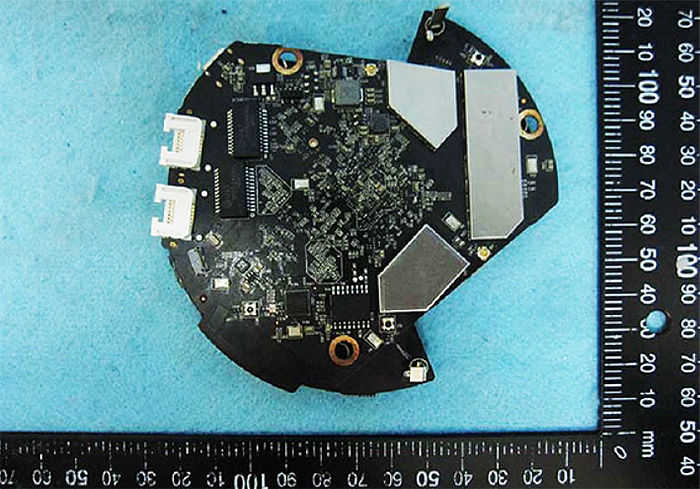
Lastly, the Deco M5 is equipped with a Bluetooth 4.2 BlueCore WLCSP chip. While Linksys Velop and Google WiFi have a ZigBee radio, TP-Link decided not to include it into its Deco M5 (weirdly enough, Google WiFi seems to have dropped the ZigBee technology from its next version).
Using the 2.4 GHz radio (and, by default the 802.11n standard), a single TP-Link Deco M5 router features a maximum theoretical data transfer rate of 400 Mbps and, using the 5GHz radio band (802.11ac standard), the maximum theoretical data transfer rate is 867 Mbps (added to 1267 and rounded to the advertised 1300 Mbps).
Features and Performance
TP-Link Deco M5 promises to DECOrate your home (or office) with WiFi leaving no corner untouched (as with other WiFi systems, the purpose is to get rid of the dead zones, where a single router isn’t able to reach). To do so, TP-Link went the same road as the Velop, Eero (first and second generation) and Google WiFi and implemented the mesh technology. Some of you may be aware by the fact that the mesh tech is not something new and no, these domestic-type of systems aren’t the first ones to use it. In reality, it was something more suitable for enterprise use because of its insanely high cost.
You could call Eero or Open Mesh some sort of pioneers since they were among the first to bring the home-suited mesh systems into the mainstream, but with the ever increasing popularity of IoT products, it was a matter of time until every other major networking manufacturer would release their own products. The Deco M5 takes advantage of the unique capabilities of a mesh network and, just as with the other tongue-in-the-cheek expressions (but definitely witty, such as paint the house with WiFi), TP-Link uses what is called the ART feature (Adaptive Routing Technology). To get a better understanding of what ART can do, let’s first see hows does a mesh network operate.
In order to create a mesh network, you need more than two nodes (which, in the case of WiFi systems, are identical routers), with one unit connected to the Internet and the next units spread around a larger area to cover as much space as possible and eliminate any zones where the signal can’t reach. The main property of any mesh network is the ability of creating an interconnected system, where each unit can connect to any other node based on a certain set of conditions (such as the signal strength, the available bandwidth, the less crowded channels, the number of node, the number of clients and so on).
This emphasizes the way a mesh system adapts to the pre-existing network conditions and finds the fastest and most efficient route for the data to reach its destination. Furthermore, in case a node fails, the whole network continues to function and the data is being re-routed through the nearest units, so you won’t experience any downtime and you can continue to seamlessly roam a larger area without noticing any major changes (of course, the signal will be less powerful in that specific area). If you add a new node to the system, again, the whole network will rearrange itself to ensure the best paths for the transmitted/received data.
Besides taking advantage of the mesh technology abilities, TP-Link also uses the aforementioned ART feature which has the role of connecting your devices to the most favourable M5 node (node-steering) and it also helps find the clearest path for your clients (for this to happen, the Deco M5 has a single SSID and, similarly to every other WiFi system, you can’t manually choose which client connects to which band or channel, this whole process remains purely automatic).
It’s true that the mesh approach appears to be very interesting and promising, but, similarly to the router + extender setup, it still is plagued by the same problems which it has not yet fully solved.
Of course, I’m talking about latency and the backhaul traffic. As you add more nodes (Deco M5 routers) to the system, you will notice that the connection quality and throughput declines. This is something normal with any multi-hop system and the main solution for keeping things in check is not using too many nodes (three seems to be the sweet spot) and properly handling the backhaul traffic. I can’t really say that TP-Link Deco M5 has done anything more than Eero or Google WiFi in terms of wirelessly handling the backhaul (not much can be done with a dual-band router, since no manufacturer would keep only a single radio and most prefer for the devices to be able to travel between at least two bands), but, similarly to the aforementioned two wireless mesh systems, it supports Ethernet backhaul. I know that it pretty much defeats the purpose of a WiFi system, but at least, you could have a mixed network to be able to handle things properly.
Of course, there are better solutions out there: Linksys Velop uses three radio bands for both backhaul and client connection (and, of course, Ethernet backhaul), while the best solution so far comes from Netgear Orbi which dedicated an entire 5GHz radio band for backhaul and it paid off well, since two connected Orbi devices (main router + satellite) have pretty much the same wireless performance.

Mark is a graduate in Computer Science, having gathered valuable experience over the years working in IT as a programmer. Mark is also the main tech writer for MBReviews.com, covering not only his passion, the networking devices, but also other cool electronic gadgets that you may find useful for your every day life.

